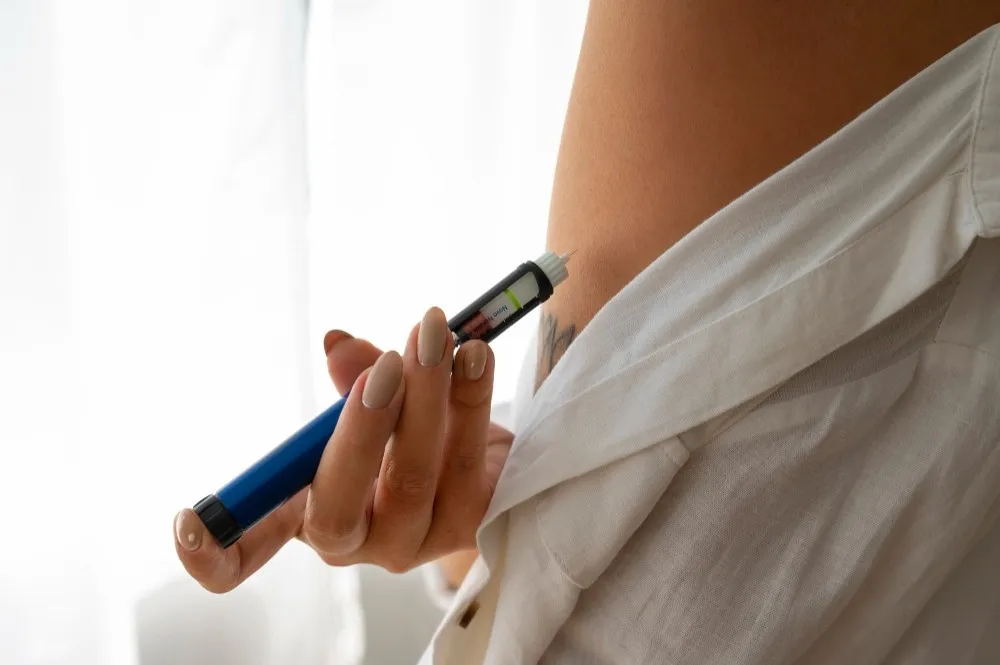Have you ever had an antibiotic and suddenly felt like your skin was burning, turning red like a sunburn? That’s Red Man Syndrome (RMS)—a condition linked primarily to the antibiotic vancomycin.
Think of it as your body sounding a false alarm. Though alarming, it’s manageable. It causes intense skin flushing, itching, and rash.
While it may look severe, understanding its causes, symptoms, and preventive measures can help ease concerns. In this article, we’ll break down everything you need to know about this condition, ensuring you’re informed and prepared if you or a loved one ever encounters it. So let's get started!
Is Red Man Syndrome an Allergy?
No, it’s not an allergy. Unlike allergic reactions, RMS doesn’t involve the immune system attacking the drug. Instead, it happens when vancomycin triggers a rapid histamine release in the body, causing intense flushing, redness, and itching.
It can occur during or shortly after IV infusion and, while uncomfortable, is usually preventable and treatable.
Causes of Red Man Syndrome
Red man syndrome doesn’t happen by chance. Specific factors tied to vancomycin administration or patient physiology trigger this reaction. Understanding these causes helps mitigate risks and improve outcomes.
1. Rapid Infusion Speed (Most Common Cause)
Administering vancomycin too quickly floods the bloodstream, overwhelming mast cells.
Slow drips (60+ minutes) prevent abrupt histamine spikes.
Hospitals follow protocols to regulate infusion rates strictly.
Ignoring speed guidelines raises reaction risks.
2. High Dosage Levels
Larger doses increase histamine release from immune cells.
Doctors calculate doses using weight and kidney function.
Pediatric patients need adjusted amounts to avoid overload.
Overdosing amplifies redness, itching, and systemic symptoms.
3. Prior Exposure to Vancomycin
Previous reactions prime the immune system for sensitivity.
Repeat episodes often hit faster and harder.
Always disclose past vancomycin use to your care team.
Allergy testing helps identify recurring risks.
4. Concurrent Medications
Opioids, NSAIDs, or muscle relaxants worsen histamine effects.
Drug interactions create a “double hit” on mast cells.
Review all medications before starting vancomycin.
Pharmacists adjust regimens to minimize conflicts.
5. Genetic Sensitivity
Genetic factors influence histamine response intensity.
Some bodies overreact even to slow, low-dose infusions.
Testing for IgE antibodies can predict susceptibility.
Personalized treatment plans curb unnecessary risks.
6. Dehydration
Low fluid volume concentrates vancomycin in the bloodstream.
Hydration before infusion dilutes the drug’s impact.
IV fluids pre-treatment reduce symptom severity.
Dehydrated patients face a higher likelihood of reactions.
Symptoms of Red Man Syndrome
Spotting red man syndrome early prevents complications. Symptoms often start during or right after infusion. Watch for:
Intense redness (face, neck, chest)
Burning or itching sensation
Rash resembling sunburn
Sudden fever or chills
Dizziness or lightheadedness
Rapid heartbeat
Swelling around eyes/hands
Flushing spreading to arms/torso
Severe cases may cause breathing difficulty or fainting, requiring urgent care.
Diagnosing Red Man Syndrome
Doctors use a mix of observation and testing. No single test confirms it, but these steps help:
Physical exam focusing on rash pattern.
Review of recent vancomycin use.
Ruling out true allergies (e.g., hives, anaphylaxis).
Drug challenge test under supervision.
Blood tests to exclude infections.
Skin biopsy in uncertain cases.
Monitoring during future infusions.
Consulting allergists for recurrent cases.
Best Treatments for Red Man Syndrome
Act fast if symptoms hit. Treatment focuses on relief and preventing escalation.
1. Stop or Slow the Infusion
- Pausing the IV stops symptoms from worsening.
- Restart at a slower rate (over 90 minutes) if needed.
2. Antihistamines (First-Line Treatment)
- Diphenhydramine (Benadryl) blocks histamine to reduce redness & itching.
- Often given before future vancomycin infusions to prevent RMS.
3. IV Fluids
Helps flush vancomycin from the system and stabilize blood pressure.
4. Corticosteroids (For Severe Cases)
Prednisone or hydrocortisone reduces swelling and inflammation.
5. Switch to Alternative Antibiotics
If RMS is severe, other antibiotics like daptomycin or linezolid may be considered.
6. Slower Infusion Rates
Future doses given over 60+ minutes.
7. Monitor Vital Signs
Heart rate & blood pressure should be checked closely until symptoms resolve.
8. Follow-Up Care
Ensure symptoms don’t rebound post-treatment.
Prevention: How to Avoid Red Man Syndrome
Preventing red man syndrome hinges on smart practices which can drastically reduce the risk. Here’s what works:
Prevention Strategy | How It Helps |
Slow IV Infusion | Lowers histamine surge risk |
Pre-Medicate with Antihistamines | Blocks histamine receptors preemptively |
Correct Dosage Calculation | Avoids overwhelming the body |
Monitor During Infusion | Catches early signs fast |
Avoid Trigger Medications | Reduces synergistic reactions |
Patient Education | Ensures prompt symptom reporting |
Research shows slowing vancomycin infusion cuts red man syndrome risk highly.
Living with Red Man Syndrome: Tips to Manage
Managing red man syndrome long-term means staying proactive. RMS can be managed with awareness and precaution:
- Always inform new doctors about past RMS reactions.
- Wear a medical ID card stating your sensitivity to vancomycin.
- If vancomycin is necessary and unavoidable, insist on pre-medication and slower infusions.
- Track symptoms in a journal—note timing, severity, and triggers.
- Join online forums or support groups to share experiences and tips
Most importantly, know this isn’t a life sentence. With vigilance, you can navigate treatments safely. Advocate for your own safety in medical settings.
When to See a Doctor
Don’t brush off these red flags. Seek help immediately if you notice:
Trouble breathing or chest tightness.
Symptoms during/after vancomycin infusion.
Rash spreading rapidly.
No improvement after antihistamines.
Recurrent episodes despite precautions.
History of RMS and new antibiotic use.
Swelling blocking airways.
Confusion or fainting.
Conclusion: Take Control of Red Man Syndrome
Red man syndrome might feel overwhelming, but knowledge turns the tide. If you’ve experienced symptoms or are about to start vancomycin, consult your doctor immediately. Discuss infusion protocols, pre-medication options, and alternative antibiotics.
Share this guide with friends or family—awareness saves lives. Remember, proactive communication with healthcare providers ensures safer treatments. Don’t wait for redness to spread; act fast, stay informed, and prioritize your health. Together, we can outsmart red man syndrome.
अक्सर पूछे जाने वाले प्रश्नों
Can red man syndrome be fatal?
No, but severe cases need urgent care to prevent complications.
Does RMS occur with antibiotics other than vancomycin?
Rarely. Cases linked to ciprofloxacin or teicoplanin are anecdotal.
Can children develop red man syndrome?
Yes. Kids on vancomycin require careful monitoring.
Is RMS contagious?
Absolutely not. It’s a drug reaction, not an infection.
Can I reuse vancomycin after RMS?
Sometimes, with slower infusions and pre-medication. Consult your doctor.
Does RMS cause long-term damage?
No. Symptoms resolve once treatment stops.
How is RMS different from anaphylaxis?
RMS lacks throat swelling or low blood pressure, hallmarks of anaphylaxis.
लेखक





